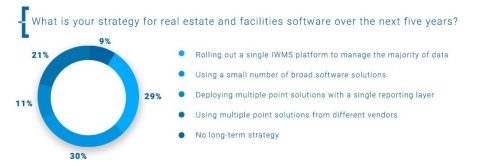There are many starting points in an organisation’s search for software solutions to enhance real estate and facility management processes. One question that comes to mind is: ‘What are the processes that should be optimised?’ But although important, determining which real estate and facilities processes need attention is not the only concern. There are more aspects to consider.
For instance, do you want broad and generic features or is there a specific need to have the latest in-depth functionality? Are you looking for a solution that you can implement immediately? Are you interested in consolidating your IT landscape and aiming to centralise your data to get a unified view? And what about the avoidance of vendor lock-in? These questions, together with business automation options available today, make it a real challenge to align your teams (leadership, IT, RE & FM) on the priorities for real estate and facilities software and to pursue the strategy that best fits the main objectives of your organisation.
It might be reassuring to know that you are not the only one addressing this. Research by Verdantix – an independent market analyst – shows that executives in real estate and facilities indicated last year that they will be expanding their software deployments and are also putting more money aside this year to further automate processes in real estate and facilities. It seems like a significant number of organisations will be searching for the answers to those questions mentioned above.
It is interesting to dive into this a bit further. What software strategies are organisations currently adopting? And more importantly: what is their motivation behind this? Finding an answer to these questions can help you determine your options. So, where do you start?
Four key real estate IT strategies
Verdantix recently published the research report 'Real Estate IT Strategies: IWMS, Point Solutions, And Everything In Between'. For this report, more than 300 real estate and facility management executives across the globe were interviewed and asked which IT strategy they envision for their real estate and facilities processes over the next five years. Their feedback revealed these four major real estate and facility management IT strategies that organisations are leveraging:
The report also identifies the main motivators for choosing one of these four strategies. They are compared, based on six crucial perspectives: Data management, User interface, Reporting and dashboards, Functionality, Vendor management, and IT support. It also touches upon exactly what is possible through each of these strategies in light of the rise of APIs and vendors who invest in platforms to improve flexibility.
Do you need a clear and concise overview of the differences between these four major real estate IT strategies and do you want to stay on top of the latest developments? Then this Verdantix report will definitely be an interesting read for you!
Important questions to ask
‘So what is the best real estate software strategy to choose?’ You’ll probably guess there is no single answer to this question. Each strategy comes with its own advantages and disadvantages, and these might not all be noticeable in the short term. For that reason, both direct and anticipated future implications should be incorporated into your decision-making to really understand what you are buying into over the long term.
The following four questions – explained further in the Verdantix report – are really useful as they represent the most important decision criteria. They help you determine your priorities and choose the most suitable real estate IT strategy:
- To what extent do I want to centralise data into a single solution?
- On what scale do I want to deploy the solution?
- How complex are my functionality requirements?
- To what extent do I want the flexibility to swap solutions in and out of my tech stack?


